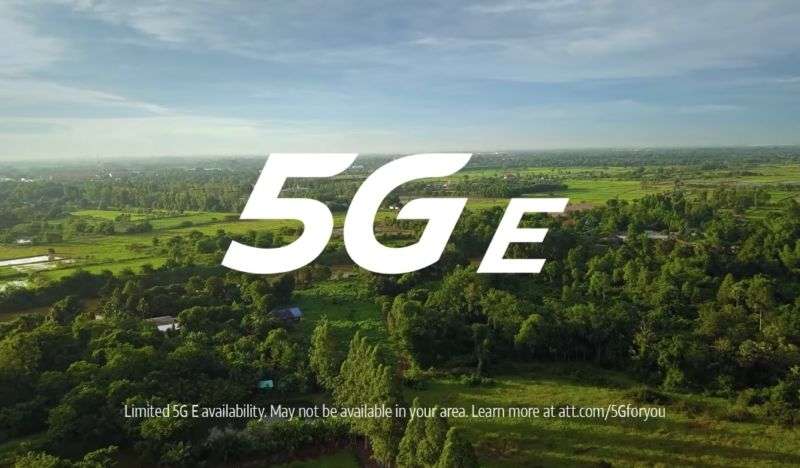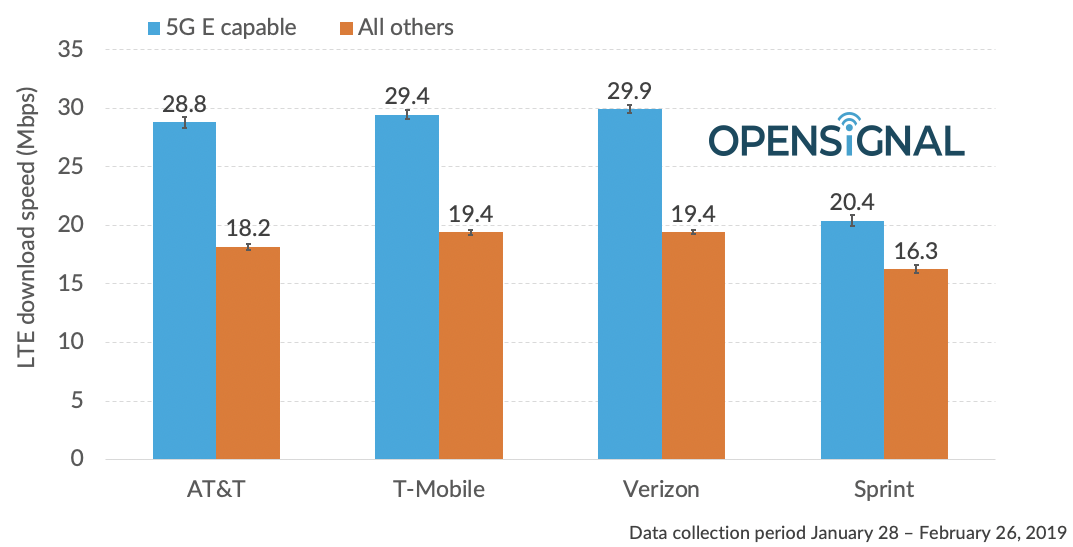
AT&T’s “5G E” is actually slower than Verizon and T-Mobile 4G, study finds

AT&T’s “5G E” service is slightly slower than Verizon’s and T-Mobile’s advanced 4G LTE networks, a study by OpenSignal has found.
As Ars readers know, AT&T renamed a large portion of its 4G network, calling it “5G E,” for “5G Evolution.” If you see a 5G E indicator on an AT&T phone, that means you’re connected to a portion of AT&T’s 4G LTE network that supports standard LTE-Advanced features such as 256 QAM, 4×4 MIMO, and three-way carrier aggregation. All four major carriers have rolled out LTE-Advanced. But while Verizon, Sprint, and T-Mobile accurately call it 4G, AT&T calls it 5G E.
Sprint sued AT&T, alleging that AT&T is gaining an unfair advantage by making false and misleading claims to consumers.
AT&T’s network name change may well trick consumers into thinking they’re getting better service than a 4G operator, but they aren’t. We already knew that 5G E has no technological advantage over LTE-Advanced, because they are the same thing with different names. But actual speed tests could reinforce that point.
Such data now comes from an OpenSignal report that is scheduled to go live at this link today at 9am ET. After comparing user-initiated speed tests from more than 1 million devices, OpenSignal found that AT&T’s “5G E” phones get average speeds of 28.8Mbps, which is less than T-Mobile’s 29.4Mbps and Verizon’s 29.9Mbps but higher than Sprint’s 20.4Mbps. The AT&T average of 18.2Mbps on non-advanced LTE was also slightly behind T-Mobile and Verizon but ahead of Sprint:

In other words, AT&T’s 5G E speeds are typical LTE-Advanced speeds. It is a real upgrade over the older portions of AT&T’s 4G network, but that’s true for all four carriers.
“Our analysis shows that AT&T customers with 5G E in their status bars are receiving up to a 60 percent boost in speeds over AT&T customers without it,” OpenSignal CEO Brendan Gill said in a statement to Ars. “Of course, our analysis also shows that the same is true for the equivalent Verizon and T-Mobile customers even though they don’t see a ‘5G E’ label on their device. Bottom line, if one service is offering a meaningful boost over another, it probably should be labeled differently, just not with a name that confuses customers.”
Crowdsourced testing
OpenSignal data is based on crowdsourced speed tests that can be performed by anyone using OpenSignal’s apps for iPhone and Android. OpenSignal told us today’s report is based on tests on 1,057,522 devices nationwide, across all four carriers, between January 28 and February 26.
The tests don’t automatically distinguish between LTE-Advanced and regular 4G LTE networks. But OpenSignal is able to distinguish between phone models, and it compared the phones that AT&T says are 5G E-capable to those that aren’t. The resulting data thus compares LTE-Advanced phones to non-LTE-Advanced phones, regardless of whether the tests were conducted in a location where the network supports LTE-Advanced features.
When contacted by Ars, AT&T argued that this limitation invalidates the results.
“OpenSignal’s note reveals their methodology is flawed,” AT&T told Ars. “Speed-test data purporting to show the ‘real-world experience of 5G Evolution’ without verifying the capable devices were tested in a 5G Evolution coverage area as shown by the indicator does not accurately represent the 5G Evolution user experience.”
But all four carriers were measured the same way, and the resulting data may reflect the breadth of each carrier’s LTE-Advanced deployment. Carriers that have deployed more LTE-Advanced coverage across the US would likely get higher speed-test results than carriers that haven’t upgraded their networks to the same extent.
We don’t know exactly how much LTE-Advanced coverage each carrier has. But AT&T has repeatedly boasted about the size of its 5G E/LTE-Advanced footprint, saying it covers more than 400 markets across the United States. If AT&T’s 5G E was significantly faster or more widespread than other carriers’ LTE-Advanced service, the OpenSignal tests probably would have found a big speed difference in AT&T’s favor. Instead, the results showed higher average speeds for Verizon and T-Mobile.
AT&T offered no further comment.
The new results are consistent with OpenSignal’s previous testing. OpenSignal’s overall data on consumer 4G experiences, released in January, showed that AT&T lagged behind Verizon and T-Mobile in 4G availability, video quality, and both download and upload speeds.
OpenSignal’s testing doesn’t yet tell us what speeds consumers can expect when they get real 5G. But the data shows “the extent to which LTE, or 4G, networks have improved since LTE’s original launch,” OpenSignal wrote in today’s report. Deployment of LTE-Advanced technology has created “a much faster experience than the initial version of 4G that was launched back in 2009-2011” but no real advantage for AT&T over its top rivals.
If you’ve been following the AT&T 5G E story, the OpenSignal results won’t surprise you. But if you know anyone who’s confused by AT&T’s misleading marketing, now you’ve got some data to help clear things up.




